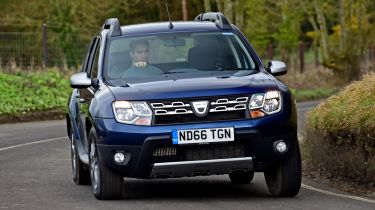Dacia Duster (2009-2017) review - Practicality, comfort and boot space
Roomy, practical and with a big boot, the Duster takes some beating in the usability stakes

The Duster may be priced like a supermini but one of its key showroom draws is the amount of space it offers. It’s a similar size to the Nissan Qashqai on the outside and this is reflected in the amount of space within – for drivers, passenger and luggage. Sensibly, Dacia only offers the Duster as a five-seater.
Size
At 4,315mm long, the Duster is just 55mm shorter than a Qashqai, and it’s actually a bit longer and wider than regular hatchbacks such as the Hyundai i30. It’s of course higher off the ground than a regular family hatch – at 1,695mm tall, it’s actually the same height as the more SUV-styled Nissan X-Trail.
Another key advantage over less SUV-biased models is ground clearance. The standard Duster can clear obstacles 205mm tall and the 4x4 version has an additional slight advantage in terms of ground clearance, offering 210mm. This can pay dividends in the urban jungle, not just off road.
Leg room, head room & passenger space
All occupants will appreciate the Duster’s tall design. It gives a better view out for driver and passengers and the fact that you step into it rather than lowering yourself down makes access easier. Getting in won’t be a struggle and neither will helping children do up their seat belts in the back.
Used - available now

2019 Dacia
Duster
60,761 milesManualPetrol1.6L
Cash £8,239
2023 Dacia
Duster
16,251 milesManualPetrol1.0L
Cash £13,895
2023 Dacia
Duster
22,953 milesManualPetrol1.0L
Cash £12,995
2022 Dacia
Duster
23,173 milesManualPetrol1.3L
Cash £12,699The driving position is decent but do note, a height-adjustable driver’s seat is not fitted to base Access models. The ergonomics leave a little to be desired, too, as it’s difficult to see the upright seven-inch touchscreen even with the driver’s seat in the lowest position.
As for storage, there’s a big tray on top of the dashboard, with a handy ledge featuring the Duster nameplate above the glovebox and another tray underneath the sat-nav. However, the speaker pods eat into space in the door bins, while quirks such as the mirror control underneath the handbrake are a bit annoying.
Rear seat access and roominess is impressive for a car so competitively priced; three people can be loaded into the back, making it a viable family car choice. Just note, the rear seat is a bit soft, so for regular long journeys fully-laden, you may prefer a more conventional car such as a Ford Focus.
Boot
The Dacia Duster has a superb 475-litre boot. This is much bigger than models such as the Ford Focus (363 litres) and Volkswagen Golf (380 litres), and it can stretch to 1,636 litres with the seats folded. Again, though, the Access suffers here as the Duster doesn’t have a split-fold rear seat as standard.
4x4 versions of the Duster have a slightly smaller boot, due to the all-wheel drive running gear. If you have a spare wheel option, they offer 408 litres with the seats up and 1,570 litres with them down. You can choose a puncture repair kit instead though, to yield more space: 443 litres with the seats up and 1,604 litres with them folded.
The boot is a good, well planned shape and, although the boot lip is a bit higher off the ground than in a regular hatch, this actually makes it a bit easier to slide things in and get them out again. Still, those chunky wheelarches also mean the suspension doesn’t eat into the boot too much, so there’s a wide, flat area for big loads.
What the Duster lacks are any premium load bay features such as fancy tie-down points and clever sliding rear seats to trade passenger legroom for boot space. It’s a basic setup that reflects the value-led list prices – it offers space in abundance and Dacia feels for most buyers, this will be enough.
The Duster will haul a maximum braked trailer weight of 1,200kg in 4x2 guise and 1,500kg as a 4x4. Unbraked, it ranges from 615kg for the 1.6 4x2, up to 680kg for the 1.5 dCi 4x4.
Towing
Much like its no-frills approach to its cars and pricing, Dacia has kept the towing capacity of the Duster dead simple, all Dusters have a braked trailer towing capacity of 1,500kg. This means it doesn’t matter if you go for an automatic or manual, or two- or four-wheel drive, you are getting the maximum pulling power the Dacia Duster will offer.





